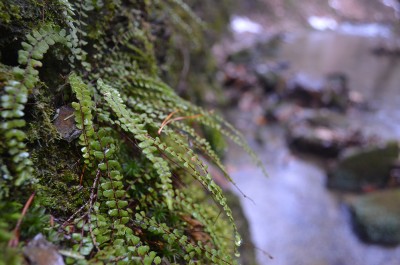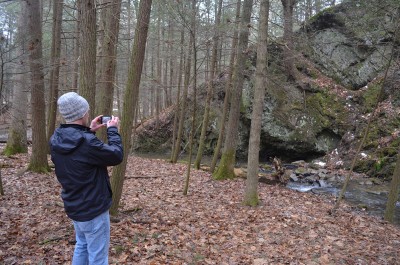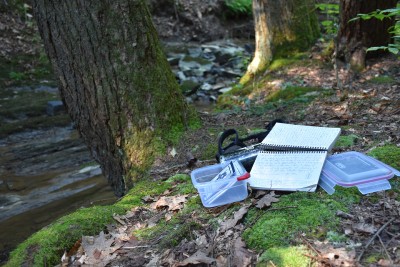A mentor of mine always told me, “There’s the real world, and there’s the actual world. Don’t confuse one with the other. This — [and he would point to the natural wilderness beyond] — this is the real world: the world we were made to know.” And I would add: the world we were made to intimately connect with.
I spent my time this past Sunday immersed in the real world and at a location on in the Stone Valley Forest affectionately named the “Dark Cliffy Spot.” (Or, to accurately tell my story, I spent more time reflecting at the actual cliff location upstream from the original “cliffy” or cliff-resembling spot.) I journeyed there to deposit a treasure-like box — a Geocache. The box is hidden now in the space of a Hemlock root system just five feet from the stream beneath my feet. 3:58 p.m. and the sun reflected off the stream onto a nearby Tulip Poplar, the water shining and dancing in rhythm to its own cascading and dripping motion; not flowing, as the creek that day only trickled, stagnant enough for the mosquitoes’ dance around my ears to nearly override the sound of the stream. I sat on the roots, formed almost as if they desired to be sat upon, and I felt patient as the ants and flies crawled across my skin, perhaps investigating the potential of a new landmark.
The Dark Cliffy Spot is one of the Creek’s eight Long-term Ecological Reflections Project sites (spoken “LTERP” or simply “Creek Journals” to conserve air). These sites around Shaver’s Creek have been chosen to reflect as a prompt for artists, citizens, and scientists to illustrate the natural and cultural history over 100 years. The idea’s conceiver, Ian Marshall, calls it a “study in place;” I see each also as a living museum — one still accessible without admission, or much judgment.
It isn’t often I intentionally travel to places I know others have already discovered and communed — not the exact places, anyway. I usually try to find a stump no one has thought to have sat upon only to see a landscape never sketched, or to hold a part of this world no one has ever touched. The desire to be an explorer: to find a spot, virgin from the negative touch of man, in an attempt to give man a more true and fitting appeal to the forest; to observe such a place in hope to feel more deeply connected and rooted in our world, which can in fact thrive without human struggle toward progress — this has always been a desire of mine. Though a notable fascination to explore new land, I’m beginning to realize that community — a connection to those around me and to those who once were — may hold a more passionate answer to living and to discovering. That somehow, the more people who place their bare feet against the same moss I had, the more I’ll also feel connected to self, to Earth, and to our human race.

Connection is the core to this fancy word we use in environmental education called interpretation. As formal interpreters Larry Beck and Ted Cable describe it, “Interpretation is an informational and inspirational process designed to enhance understanding, appreciation, and protection of our cultural and natural legacy.” Today we live in, as Neil Postman described it, the Information Age. Millions of individuals have created their own website or blog, and are able to share their thoughts, ideas, photographs, music, etc. What a truly beautiful ideal and value we have in this country of shared, online space — an avenue, no doubt to inspire and to educate. However, how many brilliant works have become lost in a web of sites? This prospect of posting to share and connect with others actually may be disconnecting us more, taking us initially outside of the moment, into our screens, and once posted, perhaps washed into the sea of links with other creative composition.

While I am not a blogger, my search for un-discovered locations is not much different than those creating a new domain name and webpage. When my journal is open to a clear page as I sit alone in the woods, I do wonder this: if I, too, continue to seek out only the spots and locations which have never been visited, to whose legacy in our world am I contributing? If I continue to only share my work in the vastness of online space, who will I begin to reach? And will I reach those who need it? Certainly there is a necessity for artists to begin with not any idea but their own. However, the formation of community through shared work may be more of a necessity than once believed. It is when we decide to explore a position of contribution rather than pioneership; when we begin to seek out the familiar home of loved ones for inspiration — the home to the Aldo Leopolds of the world, the John Muirs, the Corky Potters — we may begin to write our own verse to the passionate story of shared space.
Be it days, weeks, or years from now, when this site has been re-visited and re-discovered, perhaps you’ll, too, be patient as the ants lick the sweat from your forearms so that I may feel a phantom tickle from wherever I may be. If this is the case, I’ll be certain to face the direction of Shaver’s Creek and smile, knowing that my community and the community of the creek have not run dry. May this site see many faces, feel many feet, inspire many a creative spark, but appear as if it has seen only your own.
Enjoy the creek and please add to our community of the past, present, and future either through written word, paint, sketches, or whatever creative medium your soul desires. Venture to our many LTERP sites to feel the power of presence. And when you get there, go on and take your shoes off; the creek and those before you will feel delighted.
Always,
Caddisfly

Sources:
Beck, Larry & Cable, Ted T. (2002). Interpretation for the 21st Century: Fifteen Guiding Principles for Interpreting Nature and Culture. Urbana: Illinois, Sagamore Publishing.
